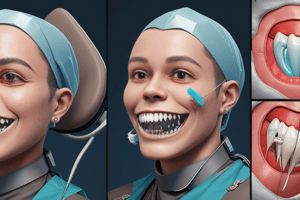Podcast
Questions and Answers
What type of necrotizing periodontal disease affects only the gingiva?
What type of necrotizing periodontal disease affects only the gingiva?
- Necrotizing stomatitis
- Necrotizing gingivitis (correct)
- Necrotizing periodontitis
- Necrotizing encephalitis
What type of soft tissue defect is most likely associated with traumatic toothbrushing in healthy periodontal tissues?
What type of soft tissue defect is most likely associated with traumatic toothbrushing in healthy periodontal tissues?
- RT1 (correct)
- RT2
- RT3
- Tooth and Prosthesis-Related Predisposing Factors
What is one of the most common symptoms of necrotizing periodontal diseases?
What is one of the most common symptoms of necrotizing periodontal diseases?
- Swelling of the lymph nodes
- Fever
- Excessive salivation
- Fetid oral odor (correct)
Which of the following is NOT a factor that predisposes to soft tissue recession?
Which of the following is NOT a factor that predisposes to soft tissue recession?
What is the most common cause of gingival recession?
What is the most common cause of gingival recession?
What type of Miller Class gingival recession is characterized by the loss of most of the interdental alveolar bone?
What type of Miller Class gingival recession is characterized by the loss of most of the interdental alveolar bone?
What type of periodontal disease is necrotizing periodontitis?
What type of periodontal disease is necrotizing periodontitis?
What type of tissue necrosis is associated with necrotizing periodontal diseases?
What type of tissue necrosis is associated with necrotizing periodontal diseases?
What type of periodontal pocket is not common in necrotizing periodontitis?
What type of periodontal pocket is not common in necrotizing periodontitis?
What type of treatment is typically used to treat necrotizing periodontitis?
What type of treatment is typically used to treat necrotizing periodontitis?
Flashcards are hidden until you start studying
Study Notes
- Necrotizing periodontal diseases are a group of destructive infections of the periodontal tissues that can cause painful tissue necrosis.
- Necrotizing gingivitis is a type of necrotizing periodontal disease that affects only the gingiva, while necrotizing periodontitis is a more severe form of the disease that affects both the gingiva and the periodontal ligament.
- Necrotizing stomatitis is a rare and severe form of necrotizing periodontal disease that affects the tongue, cheek, and palate.
- Fetid oral odor is a common symptom of necrotizing periodontal diseases, and excessive salivation is also common.
- As tissue necrosis progresses, interproximal craters may form.
- Necrotizing periodontal diseases (NP) are a group of inflammatory diseases of the gums that can damage the bone and other tissues around the teeth.
- The disease process usually involves the periodontal ligament and alveolar bone, resulting in loss of attachment.
- Deep craters in the interdental alveolar bone characterize necrotizing periodontitis.
- The deep periodontal pockets seen in other forms of periodontitis are not common in NP because the tissue necrosis destroys the marginal epithelium and connective tissue, resulting in gingival recession. Progression of the interdental disease process often results in destruction of most of the interdental bone.
- NP is often difficult to diagnose because the symptoms are mild and can be confused with other conditions.
- Systemic signs and symptoms may include swelling of the lymph nodes, fever, and malaise.
- Pre-existing gingivitis or tissue trauma can increase the risk of developing NP.
- There are three types of periodontal biotypes, and each is associated with different risk factors for developing NP.
- Gingival recession is the most common mucogingival deformity, and it is often the first sign that NP is occurring.
- NP is treatable with antibiotics and/or surgery, but it may be fatal if not treated early.
- Gingival recession is a loss of tooth height and a decrease in the thickness of the alveolar bone around teeth.
- There are four types of gingival recession, which are based on the level of gingival margin with respect to the mucogingival junction and the underlying alveolar bone.
- Gingival recession can be classified as Miller Class I, II, III, or IV, based on the severity of the recession.
- Gingival recession can be caused by a variety of factors, including age, dental disease, and improper flossing technique.
Studying That Suits You
Use AI to generate personalized quizzes and flashcards to suit your learning preferences.



